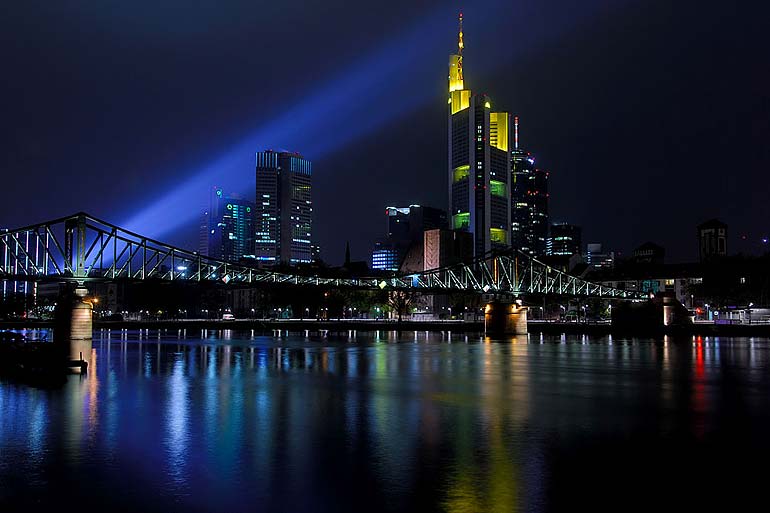Home Search Gallery How-To Books Links Workshops About Contact
Wide Dynamic Range with any Digital Camera


Frankfurt, Germany. Photo by Andreas Tofahrn using a unique process. Brilliant points of light and subtle dark details all look as they should. Bright points have vivid color and aren't burnt out to white. We could reduce exposure to retain color in the brightest highlights, but then the shadows would crush to murky black. Digital cameras can't capture the highlight range as well as our eyes or film, so the highlights wash out to white if the dark areas are given enough exposure. Film does a decent job of retaining color around points of light, however digital cameras are designed with far more of their dynamic range devoted to the shadows instead of the highlights. Digital cameras are designed this way to test better in those idiotic static noise tests, but usually look awful trying to capture color in my Christmas lights at night. So how does Andreas make these great photos on digital? Hint: it's digital, it's brilliant, and it's not Photoshop HDR. INTRODUCTION Plenty of photographers, including myself, have messed with Adobe Photoshop CS2 and the "Merge to HDR" command in the File > Automate menu. It does a great job of merging a slew of bracketed exposures into an abstract 32-bit file which represents a huge dynamic range. The problem is that this file can't be viewed directly. It first has to be converted to a format which we can see with 16 or 8 bits. Photoshop doesn't yet have the ability to map that file into an image we can see with any degree of artistic flair. Photoshop has some rudimentary ways to convert HDR to viewable 16- or 8-bit files. These rudimentary approaches rarely look good without a lot of manual tweaking. The HDR conversions I've done that have looked good don't look much different than the one correct exposure. HDR isn't ready for prime time. It needs manual tweaks to convert from HDR into a decent image, You have to twiddle with it, or take your chances with the crude tools provided with CS2. It's like color management was before Photoshop 5.5: it worked, but you had to be a master tweaker to get it to go. INTRODUCING ANDREAS TOFAHRN Andreas emailed me some knockout shots of Frankfurt at night. He uses his own manual process to select among several layers of multiple bracketed exposures to create each image. His results speak for themselves. It is his critical eye which allows such great results. Andreas' procedure allows him complete control. Automated HDR merges aren't there yet. I found his images and method very interesting, and thought you would, too. No, I'm not writing an article, since Andreas already has. You can see Andreas' process explained here, along with excellent before-and-after examples. He uses a Nikon D200 and D70. His process works with any camera. You can see more of his work here, and his main website here. Check it out if you like to shoot at night! |
Home Search Gallery How-To Books Links Workshops About Contact
